Farwell and Brady Need Changes
More turning lights, high-visibility crosswalks, make Farwell a two-way street.
The intersection of Brady, Farwell and Cambridge is one of the most prominent on the East Side of Milwaukee. Thousands of drivers, transit riders, pedestrians and bicyclists pass through it on a daily basis. Several Milwaukee County Transit System bus lines run through this intersection and it is a prominent transfer point for many. Extensive amounts of retail and high density housing surround the intersection, making it a walkable destination for thousands of nearby residents. This intersection is also a gateway to Brady Street – one of the finest retail streets in the city. It is one of the liveliest and busiest intersections in Milwaukee and with that, it deserves due attention and care. While this meeting point has many positive attributes, several relatively easy changes could dramatically improve safety while simultaneously reducing congestion.
What Works
As noted, this is one of the busiest intersections on the East Side, if not the entire city. With that activity comes thousands of people in transit – this is a great trait of the intersection. The streets aren’t too wide, the crossing is signalized and crosswalks are present and in relatively good condition. Cambridge Avenue’s approach to the intersection is one piece of this equation that works well. Traffic effectively flows from Cambridge onto Brady or Farwell. Farwell has a recently repainted designated bike lane – this is a good precedent which the city should build on in the surrounding streets or bolster by creating a protected bike lane on the Farwell-Prospect Corridor.
What Doesn’t
The intersection has multiple uncontrolled left-turn opportunities which put pedestrians at risk and causes congestion in both directions on Brady Street. The lack of designated turning lanes on Brady causes traffic to back up – at rush hour this can cause drivers and transit riders to wait through several rounds of traffic lights in order to pass through. This level of congestion does not benefit the neighborhood or its businesses. On the other side of that issue, high rates of speed on Farwell reduce safety and quality of life on the corridor. Signals need to be coordinated in a manner to improve traffic flow. Let walk signals turn five seconds before paired traffic lights – give pedestrians additional time to cross the street. Bike lane markings, while present on Farwell, could be expanded onto Brady between Farwell and Prospect and ideally onto Cambridge and Brady west of Farwell. That lack of definition can make things difficult for bikers especially considering the number of right-turn lanes. Those undesignated right-turn lane areas leave bikers in a lurch as cars aggressively try to turn.
The suburban-style strip mall shopping center at this intersection has two inconvenient driveways. Those driveways both have poor sight lines and are difficult to enter and exit. The strip mall replaced a three-story historic mixed use building that had street retail. Ideally one day this center will be demolished and reconstructed with either underground parking or parking in back and not fronting the street. While parking is a major concern in the neighborhood, there are better ways to manage and handle it than through the use of an underutilized public lot on valuable land.
What Can We do to Improve It?
Farwell Avenue should be converted into a two-way street in order to slow traffic in both directions and bolster business activity. Farwell has historically been a two-way street and there have been growing calls to convert the street into a two-way corridor once again. Several downtown Milwaukee streets were successfully converted from one-way to two-way streets under Mayor John Norquist. Two-way streets have been shown to have a psychological impact which causes drivers to slow down and to stop more often. One-way streets typically encourage vehicles to stop less, drive faster and also reduce visibility which is bad for pedestrians and businesses.
As has been recommended at other intersections that I have written about, the city should install high visibility crosswalks to improve pedestrian visibility. Green MMA paint can be used to improve visibility for bicyclists. As noted above, bike visibility at this intersection is still insufficient and the right-hand turning lanes leave bikes in an awkward position. In order to relieve vehicular congestion, designated left-turn lanes should be added with paired signals to allow for an allotted turning time. Many drivers on Brady Street are turning onto either Cambridge or Farwell and that should be accommodated with designated turning signals to improve that traffic flow. Designated turning lanes and signals also reduce the chance of collisions between vehicles and pedestrians. Rather than rushed, unregulated turning, vehicles can respond to a designated turning signal and enjoy a safe right of way rather than scrambling to do so. These improvements would go a long way towards improving safety and the quality of life at this junction.
Intersection of E. Brady St., N. Farwell Ave., and N. Cambridge Ave.
Intersection
-
6 Changes Needed on Commerce & North
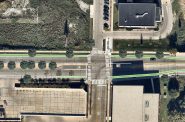 Aug 25th, 2017 by John O’Neill
Aug 25th, 2017 by John O’Neill
-
16th And Greenfield Is Chaotic
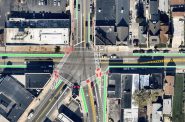 Feb 10th, 2017 by John O’Neill
Feb 10th, 2017 by John O’Neill
-
Water and Brady Is A Mess
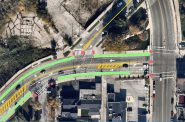 Jan 30th, 2017 by John O’Neill
Jan 30th, 2017 by John O’Neill


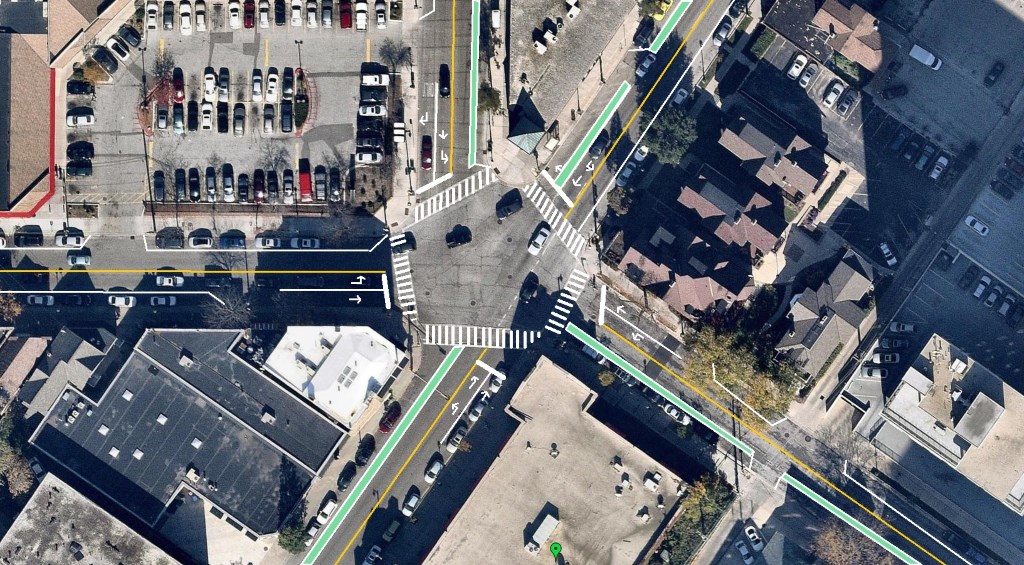
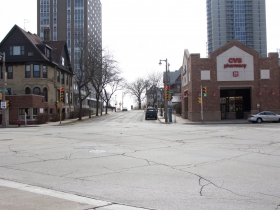
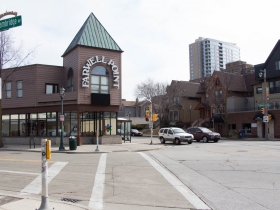
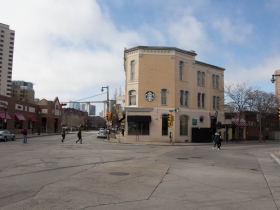
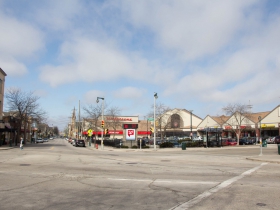
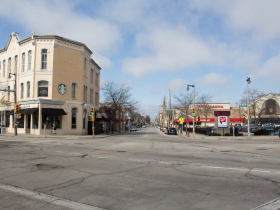
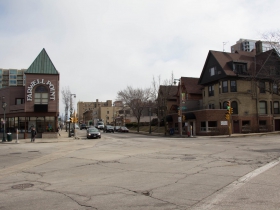















Remember the the streetcar is supposed to travel down Farwell also – further complications! http://www.themilwaukeestreetcar.com/route.php
I would also suggest making the pedestrian crossing a scramble, with its own time in the traffic signal cycle. https://en.wikipedia.org/wiki/Pedestrian_scramble
I agree with many of your points EXCEPT for the two-way conversion of Farwell and Prospect. I think these roads work very well as a coupled pair and other strategies could work to slow traffic. My thoughts for the intersection is that in the stop light cycle there should be a pedestrian only cycle allowing people to travel in all directions and lessen the confusion of who goes when, which I think would be may much worse by the conversion of Farwell to two-way. https://ibin.co/v/3HMWD45lyrku
I dislike this intersection to the point that I changed my route home from work. Cars headed east on Brady that want to turn left onto Oakland don’t seem to realize they’re turning left across oncoming traffic and that west bound traffic on Brady has the right of way to both continue on Brady or turn right onto Oakland. The bend in the intersection that cuts off sight lines, especially when west bound vehicles are waiting to turn left on Farwell, is probably the main culprit. The number of times I’ve seen cars (including MPD) turn left onto Oakland while ignoring oncoming traffic makes it a wonder that there aren’t more accidents.
Related issues: people turning the wrong way down one way streets and people trying to make a left turn from a right lane on one way streets. I live in the area and this is unfortunately fairly common, with many accidents or near accidents. I also agree on the sight lines issue for the entire neighborhood — very difficult to see oncoming cars when traffic is shielded by parked cars (and it doesn’t help when traffic is traveling fast on streets like Farwell).
if Farwell changes to two-way, then so must Prospect.
I agree on the pedestrian scramble!
So, to summarize:
Remove parking to add more driving capacity. The increased road capacity will increase speeds… and how will this help bikers & peds?
Oh yeah, a little green paint will make it better for cyclists.
Success!!
Same old broken assumptions about traffic, congestion & vitality of cities. At the risk of sounding cliche, (re)read some Jane Jacobs and try again.
I like the idea of increased visibility for pedestrians and bicycles at this intersection. I also love the idea of having the pedestrians getting a turn at the stoplight while all the cars stop. I can see what the author of the article is saying with the 2 way conversion of Farwell. The mindset driving on a 2-way street is different than the 1-way street mindset. However making Farwell 2-way isn’t a true solution to the problem.
I’m a huge biker myself so bicycle lanes, trails and parks always dominate my thought process mid-ride. I have put quite a bit of thought into this and here is what we should do. In about 2-5 years let’s remove parking on both Prospect and Farwell Avenues, give out plenty of notice so we people can adjust accordingly. Grade and re-pave both streets to make them smooth and even, looking at you Prospect Ave right after crossing the Oak Leaf Trail. Then instead of having two lanes of traffic and two lanes of parking on Prospect (and Farwell), you have two lanes of traffic, a dedicated street car/bus lane, and a protected bike lane. That also will leave much more room at the intersections for turning lanes. While we are at it, let’s remove parking from Brady Street at least until Warren Ave. The buses have such a tough time turning right on to Brady because of those on-street spots. Just imagine: turning right on to Farwell from Brady and there aren’t parked cars there! It would flow so much better with a dedicated lane.
TLDR; we can have better turning lanes, better visibility at crosswalks, reduced streetcar congestion, dedicated bike lanes and traffic that flows beautifully from Ogden to North by removing parking.
If we went by your accompanying photographs, we’d be hard pressed to see an issue! LOL!
I don’t think Farwell (or Prospect) should become two-way. One-way streets are safer for pedestrians—easier to cross because you only have to worry about traffic coming from one direction.
In Madison, Johnson & Gorham/University are an example of a well-designed pair of one-way streets. Until a few years ago, their lights were perfectly timed to enforce their posted 25 mph speed limit. As long as you went 25 mph, you would hit one green after another, mile-after-mile. Sometime after 2010, the light timing seems to have been changed to support 30 mph (even though they are all still posted at 25).
Also, Oakland ends a little north of Brady without intersecting it. The third street at this intersection is “Cambridge”.
Any stats to prove the intersection is dangerous? I don’t believe that the parking lot is “underutilized” as it is always full as far as I can tell. I think the minimall works quite well. A taller building closer to the streets would block the sun and create a more congested ambiance. The CVS should have been designed with the parking lot in front and the store in back for the same reason.
Interesting point Joe. I’d guess CVS prefers the building street side to be more engaging with passerbys.
Ed, great point about the photos. No traffic, cars parked or pedestrians!
I agree that an all walk would do well here. Not common in MKE but they seem to be safer and well liked here in Seattle.
Ps I used to live off of Brady and also avoided his intersection (at least when driving)…it’s a mess.
Author, do your columns ever see progress/changes or is it strictly editorial?
I agree with several of your redesign concepts, John, especially in converting the existing bicycle lanes on Farwell into separated (protected) bike lanes by swapping them with the parking lane or by removing a parking lane and adding bollards or another type of physical barrier. Curb extensions and curb bump-outs would also be welcome at this intersection to help mitigate traffic speeds and provide a safer environment for pedestrians.
If not made 2-way, Farwell and Prospect ought to receive road diets and lose a vehicular lane or have their lanes narrowed to further reduce speeds.
One major change that is probably controversial but would see major benefits to this neighborhood would be if all of Brady St. was shut down to vehicular traffic entirely (other than transit (busses, streetcar), bicycles and pedestrians, much the same way State St. works in Madison. This would eliminate a number of the congestion and turning issues you mention and would provide an instant benefit to patrons of Brady St. by making it a place where people can safely walk or bike and enjoy the street the way it is meant to be experienced. Cars do not add any value to a street like Brady.